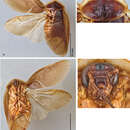Description
provided by Zookeys
Male. NB: Holotype is half spread therefore GW is estimated. Measurements. Holotype TL = 24.6 mm, GW = 13.0 mm, PW = 8.64 mm, PL = 5.60 mm, TL/GW = 1.89, PL/PW = 0.65. EW = 0.40 mm; OW = 0.60 mm. Among paratypes range of TL 20.1–30.7 mm; range of GW 9.6–15.3 mm; range of PW 7.25–10.10 mm; range of PL 4.74–6.17 mm.
Head. Two ocelli large, ovoid and protruding (0.50 × 0.40 mm); vertex dark brown, with small ridges between apices of eyes; interocellar space concave, dark brown. Frons medium brown, tectiform, concave with fine horizontal corrugations; bound on either side by ridges extending from inner apex of ocelli outwards to lateral edges of clypeus. Anterior portion of frons medium brown, bulbous; clypeal suture demarcates medium brown anteclypeus. See Fig. 33d.
Pronotum. Pronotum with broad anterior margin of translucent waxy beige, extending and narrowing laterally; variable length orange-brown setae along anterior margin; dorsal surface of pronotum covered with short orange-brown setae; pronotal pattern impressed ranging from medium brown to very dark brown, all with extensive aura; no discernible detail. See Fig. 33c.
Body. Wing brace absent. Legs and body medium orange-brown; subgenital plate asymmetrical with posterior edge emarginated, rounded apices. See Fig. 33b.
Forewings. Wings extended beyond abdominal apex (up to ~30% of the total wing length); color ranges from light brown with virtually no blotches to every level of blotchiness to uniform dark brown depending on specimen; surface opaque and matte. See Fig. 33a.
Genitalia. Right dorsal phallomere composed of bulbous lightly sclerotized wavy dorsally projecting lobe, articulated with right ventral phallomere on lateral side; central field broad, slightly sclerotized; medial margin sclerotized, with toothed edge and slight central indentation. Small central sclerite finely punctate, folded lengthwise and attached dorsally. Right ventral phallomere extends from articulation into shagreened lobe with broad indentation at posterior end and medial concavity; after narrow gap, wide concave shagreened flange. Folded anterior portion of left phallomere of moderate width, setose, otherwise unmodified. Genital hook with rounded head with moderate hook; arm smoothly curved. See Fig. 34.
- bibliographic citation
- Hopkins H (2014) A revision of the genus Arenivaga (Rehn) (Blattodea, Corydiidae), with descriptions of new species and key to the males of the genus ZooKeys 384: 1–256
- author
- Heidi Hopkins
Distribution
provided by Zookeys
Arenivaga bolliana is found across southern and eastern Texas and far northeastern Mexico. There are two isolated records in central and western Mexico, and two more in Florida. It is impossible to say if these are established populations or incidents of specimens transported by man or weather. It is hard to imagine four such incidences occurring and then the transported specimens being collected but it is remotely possible. See Fig. 35.
- bibliographic citation
- Hopkins H (2014) A revision of the genus Arenivaga (Rehn) (Blattodea, Corydiidae), with descriptions of new species and key to the males of the genus ZooKeys 384: 1–256
- author
- Heidi Hopkins

